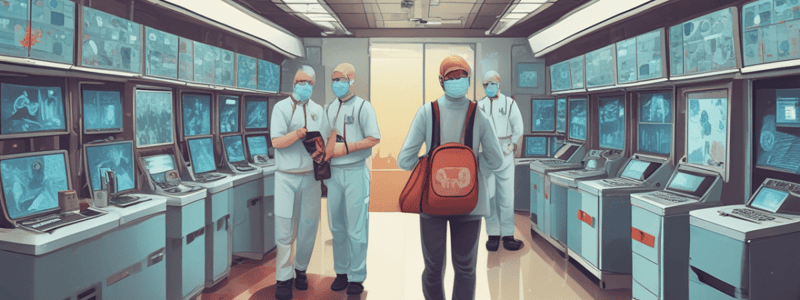Podcast
Questions and Answers
What are the two classifications of vectors that transmit diseases?
What are the two classifications of vectors that transmit diseases?
Biological vectors (such as mosquitoes and ticks) and mechanical vectors (such as flies)
What is a fomite, and provide examples of common fomites?
What is a fomite, and provide examples of common fomites?
A fomite is an inanimate object that can carry infectious agents capable of causing transmission to other individuals. Examples include dirty boots, hands, overalls, vehicles, feeding buckets, and veterinary instruments.
What is the importance of hygiene in preventing the transmission of infectious diseases?
What is the importance of hygiene in preventing the transmission of infectious diseases?
Good hygiene practices prevent vectors and fomites from carrying enough infectious agents to cause transmission, and there is a direct link between hygiene and life expectancy.
What is the recommended handwashing technique for removing germs?
What is the recommended handwashing technique for removing germs?
What is iatrogenic transfer, and how do vets play a role in it?
What is iatrogenic transfer, and how do vets play a role in it?
Why is it essential for vets to follow industry-specific requirements when handling animals or their environment?
Why is it essential for vets to follow industry-specific requirements when handling animals or their environment?
What is the primary goal of biosecurity measures?
What is the primary goal of biosecurity measures?
What is the main difference between zoonotic and non-zoonotic diseases?
What is the main difference between zoonotic and non-zoonotic diseases?
What is a reservoir in the context of infectious diseases?
What is a reservoir in the context of infectious diseases?
What is the role of vectors in the transmission of infectious diseases?
What is the role of vectors in the transmission of infectious diseases?
What is farm biosecurity, and whose responsibility is it?
What is farm biosecurity, and whose responsibility is it?
What are zoonoses, and which groups are most at risk?
What are zoonoses, and which groups are most at risk?
What is the difference between a fomite and a vector?
What is the difference between a fomite and a vector?
What is the primary objective of hygiene practices?
What is the primary objective of hygiene practices?
Flashcards are hidden until you start studying
Study Notes
Hygiene and Biosecurity
- Hygiene refers to conditions and practices that maintain health and prevent disease spread.
- Biosecurity is the management of risks to the economy, environment, and community, of pests and diseases entering, emerging, establishing, or spreading.
Principles of Biosecurity
- Prevent entry of infectious diseases
- Prevent spread if it enters (prevents establishment)
- Prevent exit of infectious diseases
- Biosecurity can be implemented off-shore, at the border, and on-farm (or any other relevant establishment)
Farm Biosecurity
- A set of measures designed to protect a property from the entry and spread of pests, diseases, and weeds
- Farm biosecurity is the responsibility of every person visiting or working on a property
- Farm biosecurity risks include zoonoses, such as Hendra virus and rabies
Zoonoses
- Any disease or infection naturally transmissible from animals to humans through bacterial, viral, and parasitic transmission, and unconventional agents
- At-risk groups include veterinarians and students
- Infectious agents can be transmitted between individuals, animals, plants, and people, and can be both zoonotic and non-zoonotic
Fomites, Vectors, and Reservoirs
- Reservoirs: the normal habitat where the infectious agent lives and reproduces, e.g., flying fox for Hendra virus
- Vector: a live agent that transmits an infectious agent from an infected animal to another animal, e.g., mosquitoes, ticks, and flies
- Fomite: an inanimate object that can carry infectious agents, e.g., dirty boots, hands, overalls, and clothes, vehicles, feeding buckets, and vet instruments
Role of Fomites and Vectors in Infectious Disease Transmission
- Fomites and vectors can transmit infectious agents to other individuals
- Examples: dirty boots, hands, and equipment
Good Hygiene Practices
- Handwashing: wash for 10 seconds to remove 90% of germs, liquid soap is sufficient
- Importance of hygiene: direct link to life expectancy, prevents vectors and fomites from carrying infectious agents, promotes a culture of cleanliness in stakeholders
Role of Veterinarians
- Vets play a crucial role in preventing the transmission of infectious agents
- Handling animals and their environment requires attention to detail and respect for industry-specific requirements
- Iatrogenic transfer: transfer of infectious agents through medical procedures, e.g., poultry and piggeries require bird-free days before entry
Studying That Suits You
Use AI to generate personalized quizzes and flashcards to suit your learning preferences.



